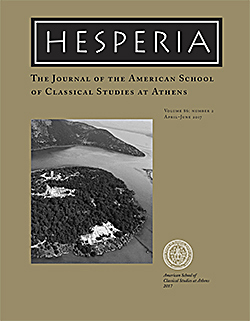Hesperia 86.2 Now Online!

The American School of Classical Studies at Athens is pleased to announce the publication of Hesperia 86.2. Topics in this issue include an overview of the ancient city of Bouthrotos (Butrint, Albania) in the Archaic and Classical periods, a reconstruction of the sculptural program of the Temple of Apollo Patroos in the Athenian Agora, the initial publication of a Hellenistic decree from Athens, and a revisiting of the area in which the Battle of Philippi took place.
Subscribers can read the issue online at JSTOR, which hosts all current issues of Hesperia as well as an archive of past volumes.
Bouthrotos (Butrint) in the Archaic and Classical Periods: The Acropolis and Temple of Athena Polias, by David Hernandez, provides a detailed introduction to the ancient Greek city of Bouthrotos in its early phases of occupation, as uncovered by the work of the Roman Forum Excavations Project. After a summary of the early excavation history and of the foundation and early years of the ancient city, the architectural remains and topography of the city are described, especially those on the acropolis, and the impacts of early settlement activities on the shoreline are discussed. Traces of monumental architecture attributed to the city’s Temple of Athena Polias are the next focus, and this material is placed in regional context. The last section of the article clarifies the various phases of the city’s fortification walls.
Hellenistic Sculpture from the Athenian Agora, Part 4: The East Pediment and Akroteria of the Temple of Apollo Patroos, by Andrew Stewart, represents the latest in a series of articles on the Hellenistic sculptural pieces uncovered during the excavations of the Athenian Agora. This article focuses on the Temple of Apollo Patroos, located on the west side of the market square, first discussing the identification of the building and its neighbors and then describing its sculptural program. A group showing Apollo Patroos and the Muses is assigned to the east pediment. A set of running Niobids and two standing figures are identified as the akroteria of the temple, presumably a representation of the slaughter of the Niobids. The article closes with a chronology of the temple and its decoration, as well as a discussion of the artist.
Judicial and Financial Administration in Late Hellenistic Athens: A New Decree of the Athenian Council, by Nikolaos Papazarkadas, presents the editio princeps of two fragmentary Hellenistic decrees discovered in Athens in 2003, including a detailed commentary on all aspects of the text. The decree, dated to 103/2 B.C., provides important new data relevant to Athenian lawcourts, financial institutions, prosopography, and administration.
The Camps of Brutus and Cassius at Philippi, 42 B.C., by Jacob Butera and Matthew Sears, takes a close look at the ancient sources that describe the Battle of Philippi, as well as earlier scholarly attempts to identify the topographical features mentioned in those accounts. An exploration of the region has enabled the authors to correctly identify the various topographical features and routes mentioned in accounts of the battle.